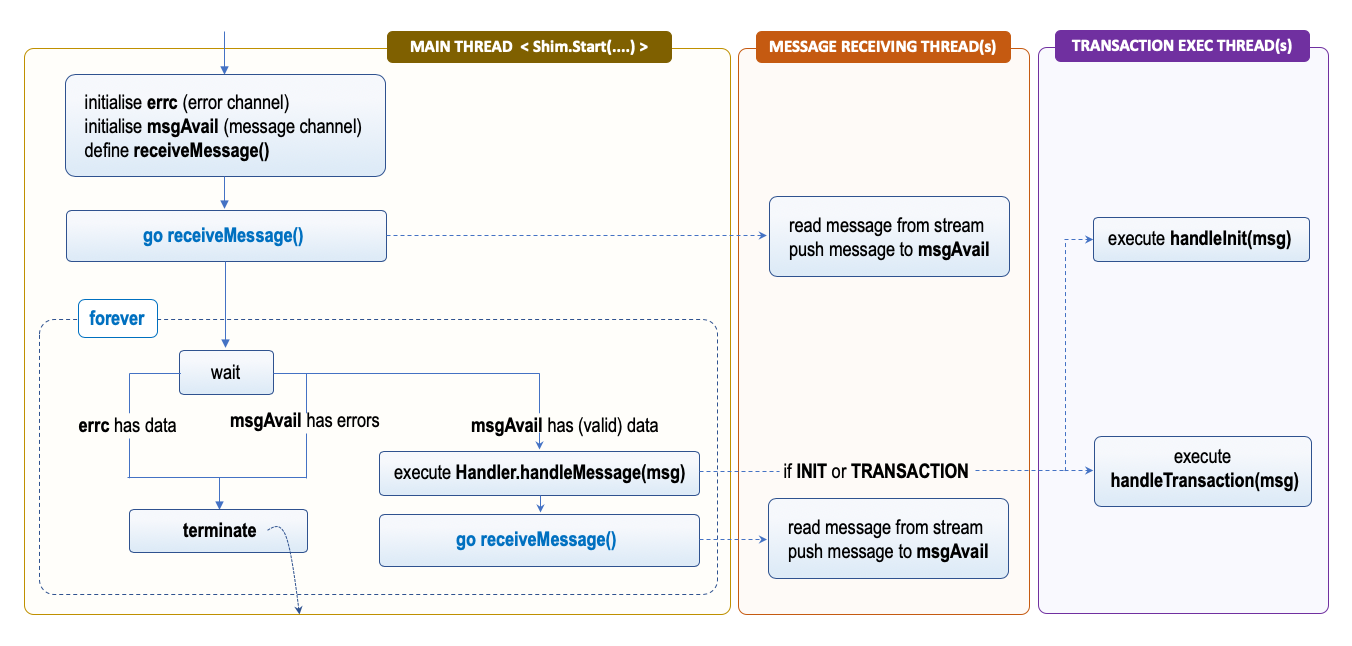Asynchronous Transaction Processing
Concurrency Model
The figure shows a view of the concurrency model implemented in the shim. For the sake of simplicity the different execution paths that are run concurrently are referred as threads regardless of their underlying implementation (i.e. green threads, go-routines, ..). Within this context the term is used simply to refer to a function executed concurrently with others.

There are three main threads that define the flow:
- Main Thread: this thread executes the entrypoint of the chaincode process, it is responsible for its initialisation and implements the infinite loop that dispatches the messages to the handler. This thread is responsible for the life-cycle of the overall process and if any unexpected error is detected in the reception of messages or the processing of proposals it terminates the process. The execution relies on two channels to:
errcandmsgAvailfrom which both incoming messages and errors are communicated to this thread. - Message Receiving Thread: this thread executes the
receiveMessage()function which listens to the bidirectional stream established with the peer and deserialises incoming data into the form ofChaincodeMessageinstances. These are then pushed through themsgAvailchannel to the main thread for further processing. Both valid data and error are passed through themsgAvailchannel. - Transaction Execution Thread: this thread executes the transaction proposal simulation, either via invoking
Handler.handleInit(*ChaincodeMessage)orHandler.handleTransaction(*ChaincodeMessage).
Note
The figure does not show the scenario where the execution of the chaincode methods results in requests made to the peer. In this case there is another short lived thread that is used to send a message through the bidirectional stream. This function is implemented in the Handler.serialSendAsync(*ChaincodeMessage,chan <- error), which simply executes in a go routine the Handler.serialSend(*ChaincodeMessage) function and pushes any error in the provided channel.
This execution model allows the chaincode process to increase the throughput of as transaction proposals are executed asynchronously thus leaving the main thread free to process other requests. Moreover, it also minimises the duration of the asychronous execution paths that operate on the bidirectional stream, since the receiveMessage() function only lives for the time required to process one message. This is quite relevant since the stream is used to both send and receive messages from different threads.
Execution of Transaction Proposal
The most interesting part of the interaction flow is the execution of transaction proposal. The listing below shows the implementation of the Handler.handleReady(...) method, which performs the dispatch of the messages based on their type to the appropriate handler function.
func (h *Handler) handleReady(msg *p.ChaincodeMessage, errc chan error) error {
switch msg.Type {
case pb.ChaincodeMessage_RESPONSE, pb.ChaincodeMessage_ERROR:
if err:= h.handleResponse(msg); err != nil {
return err
}
return nil
case pb.ChaincodeMessage_INIT:
go h.handleStubInteraction(h.handleInit, msg, errc)
return nil
case pb.ChaincodeMessage_TRANSACTION:
go h.handleStubInteraction(h.handleTransaction, msg, errc)
return nil
default:
return fmt.Errorf("[%s] Chaincode h cannot handle message (%s) while in state: %s", msg.Txid, msg.Type, h.state)
}
}
Three different cases are handled, and only two result in the asychronous execution of the chaincode methods, while the processing of RESPONSE messages from the peer is managed within the same thread.
The execution of transaction proposal is managed in the Handler.handleStubInteraction(...) which takes a function as argument, the ChaincodeMessage to process, and a reference to the error channel. The responsibility of this function is primarily error management and asynchronous communication back to the peer, the processing of the message is left to the handler function passed as first argument. This is what differentiates the execution of the INIT or the TRANSACTION proposals.
func (h *Handler) handleStubInteration(handler handleStubFunc, msg *p.ChaincodeMessage, errc chan<- error){
resp, err:= handler(msg)
if err != nil {
resp = &pb.ChaincodeMessage{Type: pb.ChaincodeMessage_ERROR,
Payload: []byte(err.Error(),
Txid: msg.Txid,
ChannelId: msg.ChannelId}
}
h.serialSendAsync(resp, errc)
}
The processing of the two types of proposals is left to the following functions:
func (h *Handler) handleInit(msg *pb.ChaincodeMessage) (*pb.ChaincodeMessage, error){ ... }
func (h *Handler) handleTransaction(msg *pb.ChaincodeMessage) (*pb.ChaincodeMessage, error){ ... }
These function have essentially the same logic comprising the following steps:
- deserialisation (unmarshalling) of the
ChaincodeInputinstance from theChaincodeMessagepayload; - creation of a new instance of the
ChaincodeStuband configuration of the transaction context comprising of channel identifier, transaction identifier, input (i.e.ChaincodeInput) and signed proposal; and - invocation of the
Chaincode.Init(ChaincodeStub)orChaincode.Invoke(ChaincodeStub)method.
If there is an invocation error the method will return a ChaincodeMessage of type ERROR, if the execution is successful it will return a message of type COMPLETED containing the response produced by the chaincode.